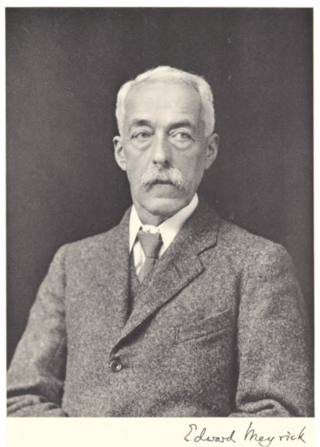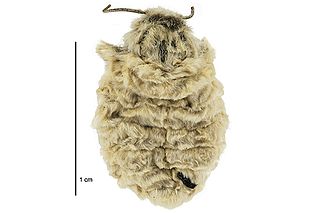
Edward Meyrick was an English schoolmaster and amateur entomologist. He was an expert on microlepidoptera and some consider him one of the founders of modern microlepidoptera systematics.

Metacrias is a genus of moths in the family Erebidae. All species are endemic to New Zealand.

Prays is a genus of moths of the family Praydidae, formerly assigned to Plutellidae or Yponomeutidae.
Xyrosaris is a genus of moths of the family Yponomeutidae.
Prays amblystola is a species of moth in the family Praydidae. It was described by Alfred Jefferis Turner in 1923 and is found in New South Wales, Australia.
Prays calycias is a species of moth in the family Praydidae. It was described by Edward Meyrick in 1907 and is found in Australia.

Zelleria cynetica is a species of moth in the family Yponomeutidae. It was first described by Edward Meyrick in 1893 and can be found in the Australian states of New South Wales, Queensland, and Tasmania.
Prays ducalis is a species of moth in the family Praydidae. It was described by English entomologist Edward Meyrick in 1914 based a single specimen collected in Sri Lanka.
Prays erebitis is a species of moth in the family Praydidae. It was described by English entomologist Edward Meyrick in 1914 based on two specimens collected in Ootacamund, India.
Prays chrysophyllae is a species of moth in the family Praydidae. It was described by Italian entomologist Filippo Silvestri in 1915 and is known from Eritrea. The larvae feed on wild olive.
Prays friesei is a species of moth in the family Praydidae. It is found on the Canary Islands and Madeira. The larvae feed on Chrysojasminum odoratissimum and Picconia excelsa.
Prays liophaea is a species of moth in the family Praydidae. It was described by English entomologist Edward Meyrick in 1927 based on two specimens collected from Stellenbosch, South Africa.
Prays peperitis is a species of moth in the family Praydidae. It was described by English entomologist Edward Meyrick in 1907 based on seven specimens collected in Sri Lanka.
Prays xeroloxa is a species of moth in the family Praydidae. It was described by English entomologist Edward Meyrick in 1935 based on larvae collected from the island of Java and reared on Harrisonia leaves.

Macarostola is a genus of moths in the family Gracillariidae. The genus was erected by Edward Meyrick in 1907.
Ascalenia semnostola is a moth in the family Cosmopterigidae. It was described by Edward Meyrick in 1897. It was described from the Australian state of New South Wales, but has also been recorded from South Africa.
Elachista demogenes is a moth in the family Elachistidae. It was described by Edward Meyrick in 1897. It is found in Australia, where it has been recorded from South Australia.
Dichomeris melichrous is a moth in the family Gelechiidae. It was described by Edward Meyrick in 1904. It is found in Australia, where it has been recorded from New South Wales.
Hypatima simulacrella is a moth in the family Gelechiidae. It was described by Edward Meyrick in 1904. It is found in Australia, where it has been recorded from New South Wales.
Heosphora is a genus of moths in the family Pyralidae. The genus was first described by Edward Meyrick in 1882. The type species is Anerastia psamathella Meyrick, 1879, designated as such by George Hampson in 1901. All Heosphora species are found in Australia.




